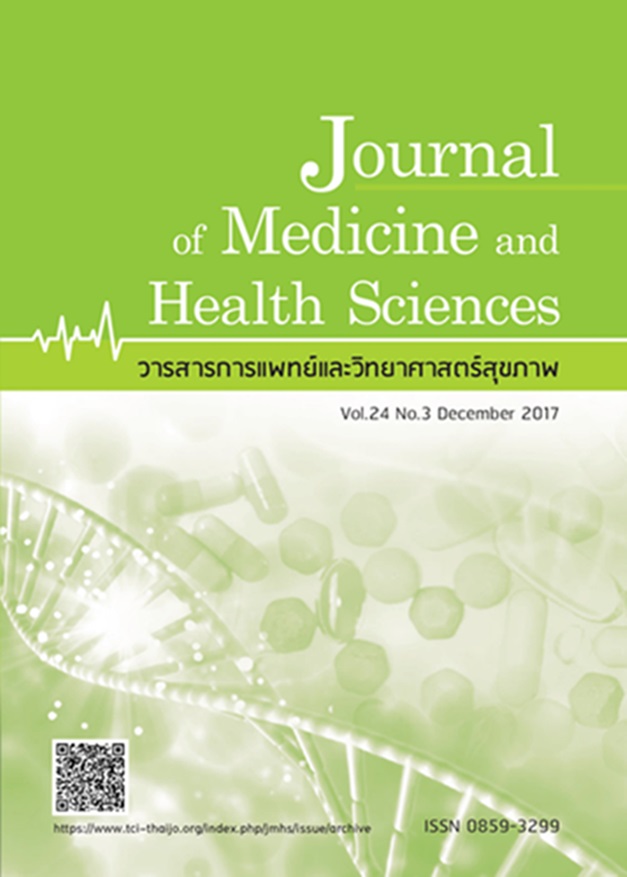ปัจจัยที่สัมพันธ์กับผลการรักษาวัณโรคที่ไม่พึงประสงค์ภายใต้รูปแบบการทำา DOT ที่ไม่ใช้ญาติผู้ป่วย: การศึกษาแบบ retrospective cohort
Keywords:
วัณโรค การรักษาแบบ DOT ไม่ใช้ญาติเป็นพี่เลี้ยง ผลการรักษาที่ไม่พึงประสงค์, tuberculosis, non-family DOT, unfavorable outcomeAbstract
การศึกษา retrospective cohort นี้มีวัตถุประสงค์เพื่อหาปัจจัยที่สัมพันธ์กับผลการรักษาวัณโรคที่ไม่พึงประสงค์ของโรงพยาบาลท่าศาลา จังหวัดนครศรีธรรมราช ซึ่งเป็นโรงพยาบาลขนาด 120 เตียง ที่ได้ดำเนินงานใช้รูปแบบการรักษาผู้ป่วยวัณโรคภายใต้การสังเกตการรับประทานยาต่อหน้าพี่เลี้ยงที่ไม่ใช่ญาติผู้ป่วยมาตั้งแต่ปี 2550 ผู้ป่วยวัณโรครายใหม่จำนวนทั้งหมด 955 รายซึ่งขึ้นทะเบียนรักษาตั้งแต่ปี 2550 – 2557 ได้รับการทบทวนประวัติการรักษาวัณโรค แต่มีจำนวน 49 รายได้ถูกตัดออกจากการศึกษาด้วยเหตุผลส่วนใหญ่จากการเปลี่ยนแปลงการวินิจฉัย กลุ่มผู้ป่วยวัณโรคที่ติดเชื้อ HIV และกลุ่มผู้ป่วยวัณโรคที่ไม่ทราบสถานะการติดเชื้อ HIV มีสัดส่วนผลการรักษาที่ไม่พึงประสงค์สูงกว่ากลุ่มผู้ป่วยวัณโรคที่ไม่ติดเชื้อ HIV โดยมี relative risks 3.55 (95% CI 2.68-4.49) และ 5.20 (95% CI 3.97-6.81) ตามลำดับ ดังนั้น จึงควรให้บริการให้คำปรึกษาและตรวจเลือดโดยความสมัครใจ กับผู้ป่วยวัณโรคทุกราย นอกจากนี้ควรศึกษาทบทวนกระบวนการดูแลรักษา HIV สำหรับผู้ป่วยวัณโรคทุกรายที่ติดเชื้อ HIV เพื่อหาข้อจำกัดในการดูแลรักษา HIV ต่อไป
This retrospective study aimed to find out factors that might be associated with unfavorable TB treatment outcomes in Thasala Hospital of Nakhon Si Thammarat province,
a 120-bed community hospital, where non-family DOT (Directly-Observed Treatment) model for TB treatment has been implemented since 2007. Nine hundred and fifty five new TB patients registered for TB treatment during 2007-2014 were reviewed, but forty-nine patients were excluded mainly due to changed diagnosis. The HIV-positive TB cases and the TB patients with unknown HIV status were more likely to have unfavorable TB treatment outcomes than HIV-negative TB patients. The relative risks were 3.55 (95% confidence interval = 2.68-4.69) and 5.20 (95% confidence interval = 3.97-6.81), respectively. VCT (voluntary counselling and testing) is strongly suggested to provide for all TB cases to get blood HIV testing, and comprehensive HIV care should be reviewed for all HIV-positive TB patients to find-out any existing limitations of HIV care.
References
Tuberculosis Report 2016. WHO/HTM/
TB/2016.13, Switzerland, 2016.
2. Ministry of Public Health, Thailand.
National Tuberculosis Control Programme
Guidelines, Thailand, 2013 (in Thai). 2nd
ed (revised). Bangkok, 2013.
3. World Health Organization. Treatment
of Tuberculosis: Guidelines for National
Programmes. 3rd ed. WHO/CDS/TB/
2003.313, Italy, 2003.
4. Rattanasuwan P. TB Treatment with DOT:
RCT vs. Effective Program Management.
Walailak J Sci & Tech 2015;12(7):581-5.
5. Iemrod K, Aryjum P. Assessment of
DOTS Intervention in Tak Province, 2001-
2003. Thai J Tuberc Chest Dis Crit Care
2004;25:193-8.
6. Anuwatnonthakate A, Limsomboon P,
Nateniyom S, et al. Directly Observed
Therapy and Improved Tuberculosis
Treatment Outcomes in Thailand. PLoS
ONE 2008;3(8): e3089. doi:10.1371/journal.
pone.0003089.
7. Rattanasuwan P, Yuanlae C, Daewa P,
et al. 12-Year Treatment Outcomes
of Tuberculosis Patients: A Full-Scale
Non-Family DOT Model in Thailand.
Walailak J Sci & Tech 2015;12(7):587-93.
8. World Health Organization. Treatment of
Tuberculosis: Guidelines. 4th ed. WHO/
HTM/TB/2009.420, 2010.
9. Sawert H, Kongsin S, Payanandana V,
et al. Cost and benefits of improving
tuberculosis control: The case of
Thailand. Soc Sci Med 1997;44(12):1805-16.
10. Yen YF, Yen MY, Shih HC, et al. Risk
factors for unfavorable outcome of
pulmonary tuberculosis in adults in
Taipei, Taiwan. Trans R Soc Trop Med Hyg
2012;106(5):303-8.
11. Amante TD, Ahemed TA. Risk factors
for unsuccessful tuberculosis treatment
outcome (failure, default and death)
in public health institutions, Eastern
Ethiopia. Pan Afr Med J 2015;20:247.
12. Iemrod K, Maokamnerd Y, Peanumlom
P, et al. Causes of death among new
smear-positive tuberculosis patients.
Buddhachinaraj Med J 2013;30(3);276-85.
13. Pokaew P, Chearsuwan A, Immsanguan
V, et al. Causes of death in new TB
patients registered in 33 hospitals in
upper northern region of Thailand during
2010. Thai J Tuberc Chest Dis Crit Care
2013;34:51-62.



